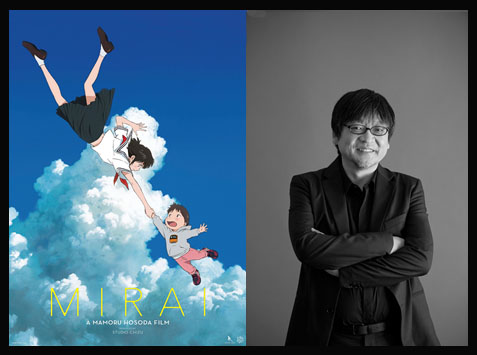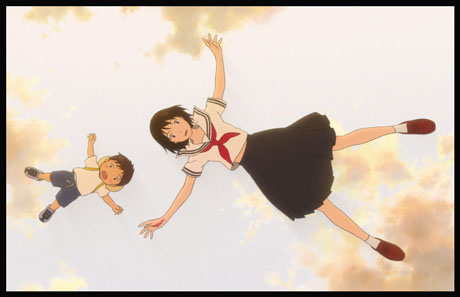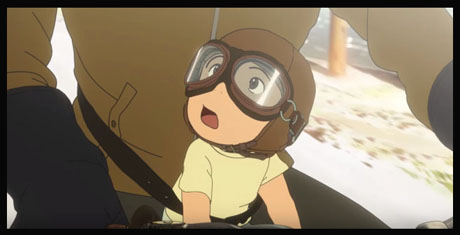
Four-year-old Kun has a problem—or so he thinks. Mom has brought home a baby sister, Mirai. Now his parents are giving lots of attention to her—attention he feels he deserves. Feeling rejected, Kun decides to run away. But when he goes as far as the family’s garden, he meets a visitor from the future: his sister as a teenager. And he is transported through time and space where he learns his family’s past, future, and in the present, his own role in the family.
Mirai — which means “future” — is the latest film from writer/director Mamoru Hosoda to be released November 29 in select theaters in North America. Hosoda has so far directed seven features, among them Digimon: The Movie (2000, with Shigeyasu Yamauchi, compiled from three short Digimon films) and One Piece: Baron Omatsuri and the Secret Island (2005). As an independent filmmaker, he directed The Girl Who Leapt Through Time (2006, based on the novel by Yasutaka Tsutsui), Summer Wars (2009), Wolf Children (2012), and The Boy and the Beast (2015). His later films derive from his own life experiences. Mirai is the result of Hosoda’s interactions with his own children, blended with adventure and a touch of magic.

Promoting his film at the Animation is Film Festival, October 21, 2018, Mamoru Hosoda talked about his career, his inspirations, Mirai, and the probability that hand-drawn films in Japan may soon become passé.
Bob Miller: On Mirai you’re the director and writer. I know Hayao Miyazaki storyboards his films. Did you storyboard the whole film yourself?
Mamoru Hosoda: Yes. I do have the idea that a director’s job is to do all the storyboarding himself or herself. I mean, I do understand like Pixar or Disney have many different storyboarders and that’s work too, but that’s how I feel on my projects.
BM: Because you control more of your vision that way, right?
MH: Yes, because the storyboards are like a layout of a design. Let’s say like a building has a layout or blueprint. The storyboarding is what the movie is layout and blueprint is so, yeah, I think the director should have control of that.
BM: What or who inspired you to become an animator?
MH: When I was in sixth grade I first learned that there was something called the storyboard. That like it’s the layout of a movie. This was in 1979 and it was Mr. Miyazaki’s Lupin the Third: Castle of Cagliostro. Then I thought I want to be that person who does the storyboards.
BM: Well, so it must have been a dream to come true when you were invited to work on Howl’s Moving Castle?
MH: This is a little complicated. When I was a student, like I could easily say Miyazaki is my hero, but then once I became a director myself I really can’t say that he’s my hero because we’re competing with each other. We’re rivals. So when I was invited to work on Howl’s, it wasn’t more that I was happy to work with him or work on something involving Mr. Miyazaki, I was happy really because they asked me to work on a feature film.

BM: Okay, your goal was to become a director from the very beginning, is that right?
MH: Actually because I was so shy, I did admire being a director but I really thought I would just be a painter or like an art teacher because when I went to college I majored in art and then so, I really didn’t think that I would have the personality to become a director, because directors should be more communicative and vocal. But when I was graduating, I ended up realizing no, I do want to be involved in making film. That’s why I joined Toei and that is how I came to be involved in as an animator.
BM: What made you decide to start your own studio, Studio Chizu?
MH: I wanted to be a director. When I was in Toei, they have a director test. So I actually took the test so that I could be directing at Toei. Studio Ghibli came and said, “Would you like to work on this feature film?” I stayed at Toei and then it was like I was just “borrowed.” I was supposed to work as a borrowed director for Ghibli. So it’s not like I quit Toei to go and work with Ghibli.
Satsuki Yamashita, translator: He was just borrowed, which happens a lot in Japanese anime industry.
BM: Interesting.
MH: But then [my involvement with] Howl’s Moving Castle fell through so then I came back to Toei but then I was like, no I still wanted to make films, so then I went to a studio called Madhouse and that’s where I made The Girl Who Leapt Through Time and Summer Wars.
So then I thought like that I was going to stay at Madhouse and continue to create more films. Then what happened was that the creator of Madhouse, Mr. [Masao] Maruyama, had to leave. Actually it’s financial reasons but a company was about to buy them out, so Mr. Maruyama was about to get kicked out. Madhouse literally was represented by Mr. Maruyama and yeah, without him all the creators were like, “Well, what am I going to do? Can we stay here and still make the products that we want to?” Obviously, if another company owns it, not really. Right? So then I had no choice to create Studio Chizu on his own.

Bob Miller (left) interviews Mamoru Hosoda (right)
BM: So you saved the jobs of your fellow animators, is that right?
MH: Technically I saved [Mr. Yuichiro] Saito who is my producer, and maybe his wife. But generally speaking, animators are just contract-based, so then if they were working for Madhouse they’ll have other jobs too, like from other studios, but as a director I wanted to continue making my own films, so that’s why.
BM: But using the same crew?
SY: Well, Mr. Saito worked on Girl Who Leapt Through Time and Summer Wars. But if the both of them said yeah, if we want to continue making movies then we have to make a studio on our own.
MH: So everything was like, we’re at the edge and this is what we had to do to survive.
BM: That’s fantastic, I salute you for that. So what was your inspiration for Mirai?
MH: So basically Mirai is really based on my children being born. I have a son and a daughter, just like in the movie. Before I had children, I really thought having children is all about trouble and hassle and having no time, being tied down and it’s all about responsibility and what we have to do as people in the society, but then once I started interacting with my children, I realized how much happiness it brings to me. It’s a very satisfying and I really realized the importance of the little things in everyday life. So then I started thinking I want to really create a movie that conveys this feeling of happiness and satisfaction and knowing the importance. That is how Mirai came to be.
BM: How does Mirai differ from other anime movies?
MH: I guess the difference between my movies and other anime movies is that it’s really based on my personal experiences. So it’s not just Mirai that’s based on my personal experience, there is Summer Wars. I made Summer Wars because I was getting married and was gaining a whole new family. Wolf Children, my mother had passed away so it was about his mother or based on his mother and then with Boy and the Beast he just had his son so he was like what is it like to be a father. I think that’s the difference with other anime films.

BM: So they’re very personal films?
MH: Yes, they are all very personal films, yes. This movie has a four-year-old boy as the protagonist—which is actually in film history, in live action or animation, I think it’s really the first to have a four-year-old boy as a main character. I know there is an animation with a baby being the main character [Boss Baby] but he’s not really a baby, he’s an adult pretending to be a baby.
But I really thought like this was important to portray because it’s like a first. It was really challenging, artistically and realistically. I really thought it was important because through the small child finding out the family history by learning different aspects of the family was really important. Then after learning everything that the family went through, this tiny boy —who’s only lived four years in his life—gets to step forward and move on with his life. I thought that was really important.
BM: Please tell us how you made it.
MH: It usually takes me about three years to make one movie. The first year is really focused on what kind of movie am I going to make and then second year is all the pre-production stuff; so writing the script, doing the character designs and the art settings, et cetera. The third year, all the animation is done. So it’s really just barely three years in order to make it.
BM: Okay, now I understand you used an architect, Makoto Tanijiri. How did you think of using an architect to design the house? I mean usually in America we have our own production designers for the films.
MH: Yes.
BM: But you went to an actual architect. How did that come about?
MH: In this film, it’s not just the house that I asked a real life architect. For the design of the Shinkansen, the bullet train, we actually asked a company or a man who designs the actual bullet trains in Japan to design our bullet train.
And then even the motorcycle, we asked someone who custom makes motorcycles.

BM: So it’s authentic?
MH: It’s very authentic. The reason was because Kun is based on my son. I wanted everything to be authentic so that it will connect. If it’s fictional, then I would usually ask an art director who is good at making up fictional stuff but because he’s my son I wanted to just make everything authentic.
BM: Oh, so your son likes trains?
MH: Yes. Yes, it’s really him.
BM: Okay, how were you able to blend the character animation with the CG animation so well?
MH: I’m really happy that you thought that the CG and the hand drawn characters blend in because right now I’m currently through a dilemma between, should we go the USA direction where we’re just going to full-on CG, or, should we keep the hand-drawn animation because it’s traditional Japanese? I’m struggling to make that balance right now. Eventually there’s probably not going to be that many more hand-drawn animators in Japan and I’m really sad about it but—
BM: That there is not going to be more?
MH: No, there’s not going to be more.
BM: Really?
MH: Yeah.
BM: Oh, no.
MH: Even my background painting was all done on paint and paper for this film. But I’m thinking this is probably the last time because these hand painters are going to lose their jobs because there is no more work out there. And so probably my next film there won’t be any hand painters available.
[From a presentation at USC with Jerry Beck, October 24]: I am in the planning process of my next film but it’s really amazing because I’m realizing, why did I start film making in the first place? I feel like I’m really going back to my roots. Everyone I’ve met is reminding me of that. But I really think that my next film is gonna be completely different from Mirai because I tend to change what I’m working on. So my growth came from drama, then I went to action, and I went to drama again. So, after Mirai will probably be something more spectacular. Yeah.
Special thanks to Satsuki Yamashita for translating our conversation.
Mirai (“Mirai no Mirai”) was released in Japan on July 30, 2018, earning a respectable $23.9 million. Its North American premiere was in Los Angeles at the Animation is Film Festival, October 21, 2018. GKIDS will distribute the film in a limited release on November 29 (dubbed and subtitled), November 30 (subtitled), December 5 (subtitled) and December 8 (dubbed).
ALSO NOTE: GKIDS and Gallery Nucleus have announced a public exhibition that highlights artwork from Hosoda’s Studio Chizu, including exclusive production artwork from Mirai. Attendees will be able to view production artwork, storyboards, and other materials from his feature films, as well as purchase items from the Studio Chizu pop-up shop, and free posters while supplies last. The exhibit will be on display at Gallery Nucleus from today to Sunday, December 2nd. The gallery is located at 210 Main Street in the Alhambra neighborhood, and offers all-ages free admission without RSVP.
- INTERVIEW: Aaron Ehasz, Justin Richmond on “The Dragon Prince: Mystery of Aaravos”: The Right Choice for the Voice - March 20, 2024
- INTERVIEW: “The Dragon Prince” Influences, Inspirations, and the Mystery of Simpson - March 11, 2024
- INTERVIEW: The Magic of Her Voice: Paula Burrows of “The Dragon Prince” - October 4, 2023


 November 29th, 2018
November 29th, 2018  W.R. Miller
W.R. Miller  Posted in
Posted in  Tags:
Tags: 






